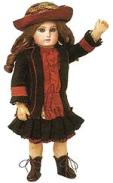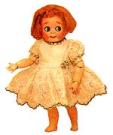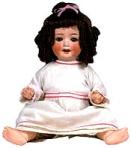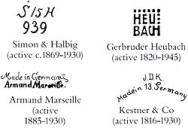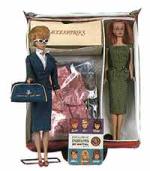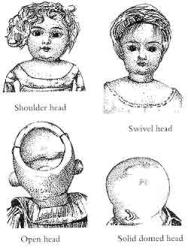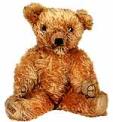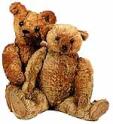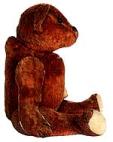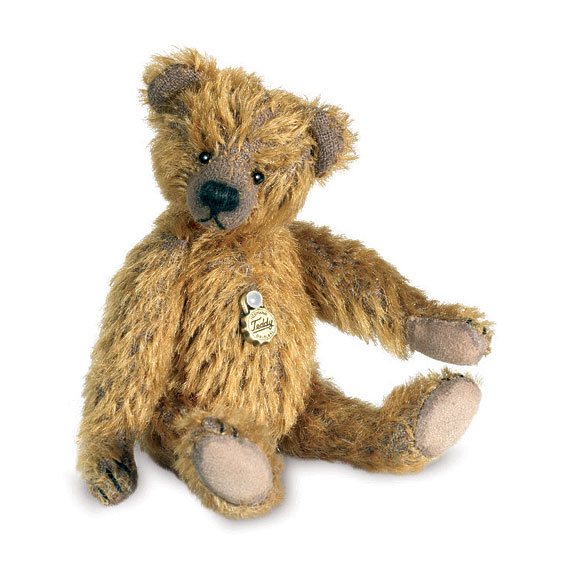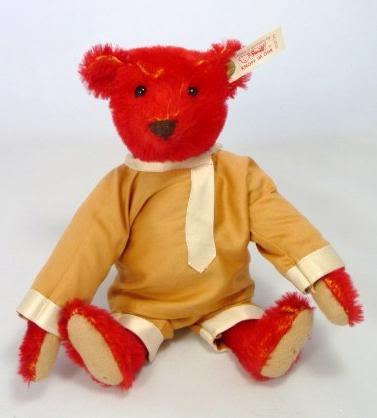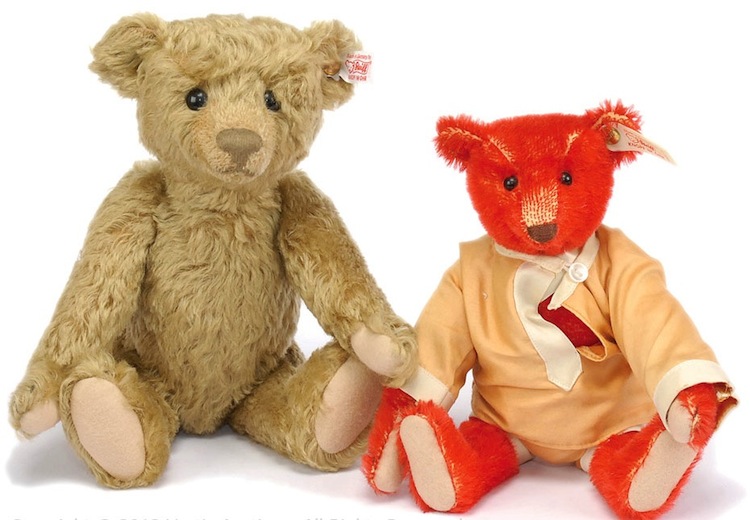Loved by girls and boys the world over, dolls and teddy bears are no longer seen as merely children’s toys – now, more and more of us are beginning to collect them too.
Dolls have been played with and treasured by children both rich and poor from the earliest times to the present day, and you don’t have to spend a fortune to build up an interesting collection.
Most dolls are categorised by collectors according to the medium of the head (which is often different from that of the body). Among the most valuable dolls are those made from wood in the 18th century and from bisque in the 19th century – both types can fetch several thousand of pounds at auction. But you don’t have to spend a fortune to build up an interesting collection. Dolls made from composition (a substance similar to papier mâchè), wax over composition and fabric are far less expensive. Clothes may add to the value of any doll. Some had extremely elaborate wardrobes and those in their original costumes command a high premium. However, don’t ignore badly dressed or even naked dolls. If your doll hasn’t a thing to wear, one way of boosting her value is to buy her a new outfit!
Teddy bears are a relatively recent addition to the collectors’ market. The jointed bear was only invented at the turn of the 20th century. The most sought-after bears are those made by Steiff, the premier maker of German bears. English bears of the 1930s and later tend to be more affordable, although equally appealing.
Bisque dolls
Bisque dolls, with heads made from unglazed, tinted porcelain, are among the most elaborate and valuable of all collectors’ dolls. Their value can range from a few hundred pounds to thousands depending on the maker, condition and quality, as well as details such as the mould number on the back of the head, and the type of mouth, eyes and body.
French bisque dolls
The finest French bisque dolls were expensive status symbols even when they were first made, and were owned by pampered children from the most affluent homes.
The earliest French bisques resembled fashionable ladies and came equipped with wardrobes of elaborate clothes, based on fashion plates of the day. The leading makers included Jumeau, Bru, Gaultier and Steiner.
Gaultier
Fashion dolls can be dated by the shape of their bodies, which were made to fit the costumes of the day. The François Gaultier doll shown at the top of the page has a narrow waist and broad hips and shoulders well suited to her bustle dress, which was fashionable in about 1870. A doll like this would be worth between £1,500 and £2,000.
Jumeau
In the second half of the 19th century, the firm of Jumeau began making dolls with child-like features, large eyes and chubby bodies known as bébés. These soon became enormously popular.
You can recognise a Jumeau by its pale-coloured bisque and large glass eyes. Dolls such as this Jumeau bébé are worth as much as £2,000 to £5,000.
Many bisque-headed dolls have composition bodies and limbs which are prone to damage. You can see this on the Jumeau bébé’s feet. Slight wear is acceptable and you should only repaint a doll as a last resort.
German character dolls
Although German manufacturers produced their own child dolls in the 19th century, they could never quite match the quality of the French bébé.
German manufacturers eventually recovered the lion’s share of the market in the early 20th century, when they introduced realistic character dolls, with crying, laughing, frowning and smiling faces.
Googly dolls
Some character dolls have very distinctive features and expressions. Dolls such as this, with roguish expressions, large round eyes and impish smiles, are known as Googlies. They’re among the most sought-after character dolls, and this one would be worth £2,000 or more.
Ernst Heubach
This bisque-headed doll, made by Ernst Heubach in about 1914, has an expressive face typical of German character dolls. She is medium quality and would be worth from £200 to £500.
- Body. This body is known as a five-piece bent-limb body, because the arms and legs are realistically bent.
- Clothes. This doll is wearing her original clothes, which adds to her value. If you need to replace your doll’s clothes you can sometimes find old baby clothes to fit larger dolls, or use old fabric to make suitable replacements.
- Hair. This doll’s value is reduced because she has a replacement wig. Original wigs are preferable.
- Eyebrows. Most bisque dolls have hand-painted eyebrows – delicately feathered brows like this are a sign of quality.
- Mouth. Open mouths were introduced in about 1900. Although this made the doll more expensive at the time, now dolls with closed mouths are more valuable.
Marks
These are some other German marks to look out for.
Wax, fabric and vinyl dolls
There are many different types of doll you can focus on collecting. Materials as varied as papier mâché, porcelain, rag, celluloid, wax, plastic and vinyl have all been used to make dolls, and different styles have come into fashion over the years. The largest group of dolls are bisque dolls, while other common ones are wax, fabric and vinyl.
Poured wax dolls
A poured wax doll like the one above, made by Montinari, is worth between £400 and £800. This type of doll has:
- hollow wax head and shoulders modelled in one piece
- stiff muslin or fabric body
- closed mouth
- inserted eyes and hair
- wax arms and legs
What to look for
- dolls by famous makers, especially Pierotti, Montinari and John Edwards
- softly modelled features
- glass eyes
- well-defined fingers and toes
Wax over composition dolls
This Pumpkin Head doll is worth between £100 and £300. The identifying features of wax over composition dolls are:
- large hollow moulded head made from papier mâché dipped in wax and painted
- eyes without pupils
- card, cloth or papier mâché body
- turned wooden legs and arms
What to look for
- good condition – these dolls are too common for damage to be acceptable
- real hair or moulded bonnets – rare but desirable
- original, colourful, elaborate clothes
Fabric dolls
This pressed felt doll made by Lenci would cost between £2,000 and £5,000. Fabric dolls have:
- moulded fabric head and stuffed fabric body
- painted or stitched facial features
- hair made from wool, cotton or mohair or painted on
What to look for
- dolls by famous makers such as Kathe Kruse, Lenci, Steiff
- expressive features – Lenci dolls have sideways-glancing eyes
- good condition – felt dolls are vulnerable to moths
- elaborate clothes with original labels
Vinyl dolls
Barbie dolls from the 1960s like this pair should fetch between £10 and £100. The identifying features of this type of doll are:
- hollow soft vinyl head
- rooted hair
- jointed limbs
- painted or inserted eyes
- registered trademark on head or body
What to look for
- Barbies with holes in the feet – these are the earliest
- Barbies with Titian or brunette hair
- dolls from the 1960s with designer-inspired wardrobes
- dolls with original packaging
- black Sindys
Types of doll head
Dolls are classified according to their head type. These illustrations show some of the most common types.
Teddy bears
Teddy bears are hugely popular with collectors. You can find English-made bears from the first half of the 20th century for a few hundred pounds, or pay thousands for rare early ones produced by famous bear makers such as Steiff.
Steiff bears
The earliest toy bears were made by Steiff in Germany at the beginning of the 20th century. The company was founded by Margarete Steiff who was crippled by polio and confined to a wheelchair as a child.
With their pointed snouts, long arms and feet and humped backs, early Steiff bears look much more like real bears than most teddies of today. In general, Steiff bears remain the most valuable of all teddies because of their unique historical appeal and exceptionally high quality.
What to look for in a Steiff
This bear from about 1908 is the most commonly seen type of Steiff bear, and it’s worth £1,000 to £2,000. The humped back is typical of early Steiffs. Later bears have less prominent humps.
- Limbs. The long curved limbs and large oval felt paws with narrow wrists and ankles are characteristic of Steiff bears.
- Plush. Most bears are made from beige or gold mohair plush. Unusual colours are more desirable. Steiff also make some bears in red, black, apricot and white mohair.
- Paws. Paw pads are usually made from felt and are especially prone to wear. This bear has replacement pads, which will affect its value.
- Button. Steiff bears are marked with a distinctive button in the ear. Early buttons have an elephant logo or were plain. Later buttons have the word Steiff.
The first teddy
Teddy bears got their name thanks to the American Ideal Toy Company. Its founder Morris Michtom was inspired by a cartoon showing Theodore Roosevelt, the US president, sparing the life of a grizzly bear. The cartoon was so popular that bears became adopted as the president’s mascot, and the story has it that Michtom wrote to ask his permission to use the name Teddy for his stuffed bears.
Other bear makers
As bears became more and more popular they were produced by increasing numbers of toy companies on both sides of the Atlantic. In England prominent companies such as Chad Valley, Merrythought, Dean’s Rag Book, Chiltern and JK Farnell enjoyed considerable success with their high-quality products.
Few bears were made during World War II. After the war production resumed, although the bears became less realistic and more like the cartoon bears of today.
English manufacturers
Several prominent English manufacturers of teddy bears prospered from about 1915 onwards. Most English bears were originally marked on fabric labels stitched to the foot. The main names are:
- Merrythought. Bears were made from the 1930s. This one has large round ears and joined claws which are typical of this maker. It’s worth about £200 to £500.
- Chad Valley. Chad bears date from the 1920s. Early bears were made of luxuriant mohair, usually gold coloured, with soft kapok-stuffed limbs. The bear pictured at the top of the page is a Chad bear, valued at £200 to £500.
- JK Farnell & Co. This company supplied teddy bears to Harrods during the 1920s and reputedly made Winnie the Pooh. The angled ears and large amber glass eyes of these bears, from around 1918, are typical of this maker. A bear like this would fetch between £300 and £1,300.
American bears
American bears, like this, were often unmarked but have distinctive wide barrel-shaped bodies, narrow arms and legs and small feet. Some have humps like German bears. This sort of bear would be worth at least £250.
Beware
Early bears had glass or shoe-button eyes, attached by wires which can come loose. Make sure young children can’t get hold of these bears and play with them.


